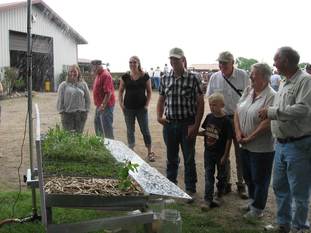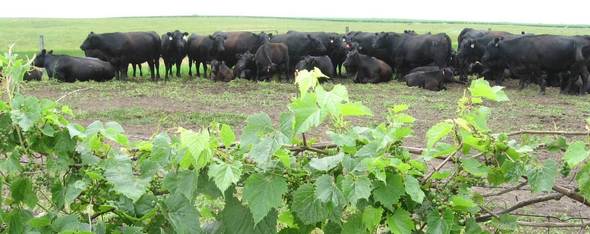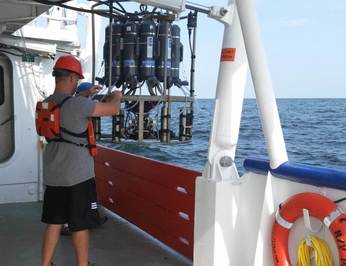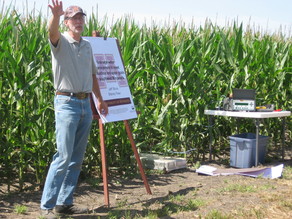 Interest in using cover crops and building soil health seems to be growing among farm producers. Registrations filled quickly for the Soil Health Field Day June 28 at the U of M West Central Research and Outreach Center at Morris. The next day, June 29, farmers and agency staff filled the large meeting room at the Renville Community Center to hear about cover crops and the experiences of local farmers. Photo: WCROC field day visitors examine cover crop samples being described by Marisol Berti, Professor of Forage and Biomass Crop Production at NDSU.
Most agree on the benefits of cover crops: Soil protection from wind and water erosion, increased soil organic matter, root 'tillage', nitrogen control, water infiltration. But to provide economic incentive, researchers are looking for more ways to cash in on cover crops. For example, camelina yields a healthy, tasty edible oil. It reduces nitrogen leaching in the soil, and also offers pollinator benefits, not to mention bio-fuel for jets. Adding cattle to a farm can generate income from cover crop forage.
Once people hear an amazing statistic about soil biology, they begin to appreciate the value of building soil health. One cup of healthy soil is said to contain nine billion microbes. Healthy soil is a living biobass that helps both crop production and water quality. The farmer panel at the Renville cover crop event agreed that while getting started can be challenging, the results are well worth the effort.
Back to top
|
 A 4R Nutrient Management field day will be held July 25 at the Dave Legvold farm near Northfield. 4Rs - Right source, Right rate, Right time, Right place - uses best management practices that optimize the efficiency of fertilizer use. The Minnesota Agricultural Water Resource Center is hosting the event and coordinating advance registration. There is no cost to attend, with expenses being covered by sponsors including The Mosaic Company, Environmental Tillage Systems and The Fertilizer Institute.
Speakers include: Tim Radatz of the MAWRC, Mark Dittrich of the MDA, Jeff Vetsch of the University of Minnesota, Melinda Sposari of TF, Steve Emory of CPS, and Adam Herges of Mosaic. CEUs will be available for Certified Crop Advisors in attendance. Photo, KYMN radio: Dave Legvold receives Minnesota Agricultural Water Quality Certification at the Conservation Technology Information Center field day at his farm in 2015. Register here.
Back to top
|
The Dept. of Agriculture (MDA) has scheduled an additional public
listening session on a proposal for regulating the use of nitrogen fertilizer
in Minnesota for 2 p.m., Tuesday, July 25, at the Holiday Inn in Fairmont. The MDA is seeking public input on a draft of the Nitrogen
Fertilizer Rule, which would help minimize the potential for nitrate-nitrogen
contamination from fertilizer in the state's groundwater and drinking water.
Nitrate is one of the most common contaminants in Minnesota's groundwater and
elevated levels of nitrate in drinking water can pose serious health concerns
for humans. Farmers
are encouraged to attend to provide public input on the proposed rule. Written
comments can also be submitted at the listening sessions, through MDA’s website
or by mail. The
draft rule and instructions for submitting comments can be viewed online.
Back to top
 The 2017
Summer Beef Tour showcased a variety of cattle operations among breeds,
systems, and even a boutique creamery. The Glacial Ridge Cattlemen's Association hosted
the day-long event, based at the Clear Springs Cattle Company south of Starbuck
in Pope County. Photo: Rainfall-infiltration demonstration at the Bar J Ranch.
At Redhead Creamery north of Brooten, the tour
visitors sampled artisan cheeses produced since 2104 by Alise Sjostrom and
family. At Clear Springs, operated by the Wulf family, the tour provided meals,
refreshments and a display area for vendors in a large monoslope barn. Other
tour stops included Highland Acres Cattle, Bar J Ranch, Bakko Brothers, feed and forage demonstration
at Nelson Red Angus, and public grazing land.
The unique geography of the Glacial Ridge
area in western Minnesota is well-suited for cattle production. In a landscape
seeming to be farther west, beef cattle graze on pasture across the rocky
hills; others feed in pens and monoslope barns, or both. Much of the artisan,
grass-fed beef popular in metro area restaurants comes from the area. The 2018 Summer Beef Tour will be July 10
at Windom, hosted by the Cottonwood
Cattle Producers.
Story July 17 in AgWeek: Central MN hosts cattle tour 'between the corn and the trees'
|
 Grape vines cling to the fence along a paddock of Black Angus at the Bar J Ranch
Back to top
 Federal
scientists forecast that this summer’s Gulf of Mexico dead zone – an area of
low to no oxygen that can kill fish and other marine life – will be
approximately 8,185 square miles, or about the size of New Jersey. This
would be the third largest dead zone recorded since monitoring began 32 years
ago – the average Gulf dead zone since then has been 5,309 square miles. - NOAA news release, 7/20/17. (NOAA photo).
This year’s predicted large size is due mainly to heavy May
stream flows, which were about 34 percent above the long-term average and
carried higher-than-average nutrient loads. The USGS estimates that 165,000 metric tons of nitrate – about 2,800
train cars of fertilizer – and 22,600 metric tons of phosphorus flowed down the
Mississippi and Atchafalaya rivers into the Gulf of Mexico in May. The USGS operates
more than 3,000 real-time stream gauges, 60 real-time nitrate sensors, and tracks trends in nutrient loads and concentrations throughout
the Mississippi-Atchafalaya watershed, which drains parts or all of 31 states.
To help reduce nutrient runoff, NOAA provides information to
farmers through its Runoff Risk Advisory Forecasts, which tell
them when to avoid applying fertilizers to their croplands.
Minnesota's nutrient reduction strategy
Minnesota and other
states in the region have developed strategies toward achieving the goal of a 45
percent reduction in phosphorus (by 2025) and nitrogen (by 2040, with interim
goal of 20 percent by 2025). On
Minnesota’s urban and crop land, combinations of tactics are needed to meet initial nutrient
reduction targets for the Mississippi and Red rivers:
- Conservation
tillage and erosion control on an additional 6.5 million acres of cropland.
- Vegetative
cover increases during spring and fall on 2.6 million acres, including cover crops
where crops are harvested early, and perennials on riparian lands and marginal
cropland.
- Fertilizer
and manure application efficiency improvements on 2.2 million acres for
phosphorus and 11.9 million acres for nitrogen.
- Storing
and treating tile line waters draining 0.6 million acres of row crops by
constructing wetlands, bioreactors and restricting drainage at non-critical
times of the year.
- Municipal
wastewater treatment improvements to greatly reduce nitrate and to address
phosphorus reduction at sites not yet fixed.
- Continued
progress on full regulatory compliance for urban runoff, feedlots and septic
systems.
To
meet long term water quality objectives, we also need additional vegetative
cover to protect soil and capture nitrate during the spring and fall months on
corn and soybean acres.
Back to top
|
 The Dept. of Agriculture has selected two projects to receive Clean Water Fund research contracts. Thirteen proposals were submitted totaling more than $2.8 million in requested funds. The two selected projects total $556,703.
Dr. Jeffrey Strock, U of M Southwest Research and Outreach Center, Lamberton, will research “Integrated Landscape Management for Agricultural Production and Water Quality.” It establishes a site where the impact of multiple, combined BMPs can be measured. Nitrogen, phosphorus, and sediment will be monitored individually and cumulatively from in-field, edge-of-field, and in-stream BMPs.
Research data collected will be used to determine the hydrologic, nitrogen, phosphorous, and sediment reduction potential of these integrated strategies and their potential for meeting Minnesota's Nutrient Reduction Strategy goals. Additionally, the project will demonstrate the ability to meet the dual goals of maintaining farm productivity while improving watershed conditions and water quality. Photo: Dr. Jeffrey Strock at field day in 2014 on Brian Hicks farm in Redwood County.
Dr. Gary Sands, U of M Dept. of Bioproducts and Biosystems Engineering, will research “Improving Design, Performance, and Implementation of Saturated Buffers.” This project seeks to increase both the effectiveness and use of saturated buffers as a BMP to reduce nitrogen loss from artificially drained agricultural lands. It will develop a planning tool to enable local professionals and conservation staff to integrate key site information into the decision-making process for siting and designing saturated buffers.
Additional information is online at mda.state.mn.us/cleanwaterfund/research. - Dept. of Agriculture news release, 6/13/17.
Back to top
|
The MPCA is requesting comment on possible amendments to chapter 7002 and 7083 rules governing water quality fees. This includes fees for municipal and industrial wastewater permits, noncontact cooling water permits, stormwater permits, feedlot permits, septic systems, environmental review, variances, and more. The MPCA may make rule changes to some or all of these fees.
The notice is available by visiting the MPCA public notice webpage. Additional information about this rulemaking, including two fact sheets, “Funding Minnesota’s water protection work” and “Public input needed on adjusting fees for water programs” are available on the Water Quality Fee Rule webpage.
The MPCA published notice in the June 26 State Register. The public comment period for this notice closes at 4:30 p.m. on Monday, Aug.14. A stakeholder video conference on this rulemaking will be held on Monday, July 24 from 2-4 p.m. and again from 6-8 p.m., at the MPCA St. Paul office and regional offices. The purpose of the meeting is to share information about this rulemaking so that stakeholders are able to provide verbal input at the meeting and written comments by Aug. 14.
Back to top
July 25: 4R Technology Review field day, Dave Legvold
farm, Northfield.
Aug. 9: Soil health field day, Ditlevson farm, Blooming Prairie, Freeborn SWCD, 507-373-5607 ext. 3.
Aug. 11: Water quality and soil health day, 9-2, Mazeppa, RSVP by Aug. 7 to Minnesota Farmers Union, 651-639-1223.
Sept. 6: Strip till expo, Fergus Falls, details TBA.
Sept. 8: Cover crop and soil health learning tour, Rushmore.
If you know of other field day events for this calendar, please
contact Forrest Peterson, 320-441-6972, forrest.peterson@state.mn.us.
Thanks!
Back to top
Dodge County feedlot legal battle is over
Rochester Post-Bulletin, 6/29/17
County board weighs in on feedlot notice changes
Perham Focus, 7/14/17
Who knew fish could ‘speak' about water quality?
KARE-11, 7/10/17
Iron enhanced sand filtration for agricultural tile drainage
U of M Stormwater Research Updates, 10/2016
House committee rejects ag lab closings
AgWeek, 7/13/17
Back to top
July 18-20: 6th
annual Red River Valley Agricultural Water Issues Forum,
8-noon, Badger (18th), Ada (19th), Dumont (20th).
July 30-Aug. 2: Soil and Water Conservation Society annual conference, Madison, WI.
July 31: Water quality town hall meeting, 6:30-8:30
p.m., Rochester Community and Technical College.
Aug. 1-3: Farm Fest, Gilfillan farm, Redwood County.
Sept. 20-21: Animal nutrition conference, City Center
Hotel, Mankato.
Sept. 26: Ag and Animal Science Conference, MinnWest
Technology Campus, Willmar.
Oct. 17-18: Minnesota Water Resources Conference, St. Paul RiverCentre.
Back
to top
The
MPCA Feedlot Update welcomes news from partners about, projects, people, and
upcoming events. Email submissions to forrest.peterson@state.mn.us.
Past issues of Feedlot Update are available on the feedlot program publications webpage.
|